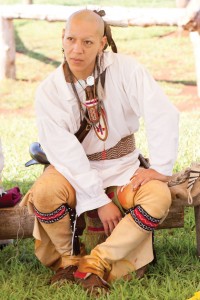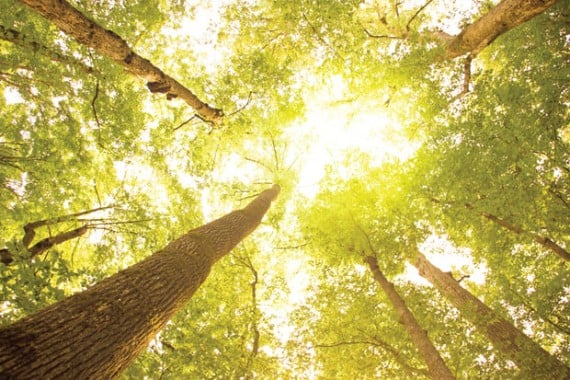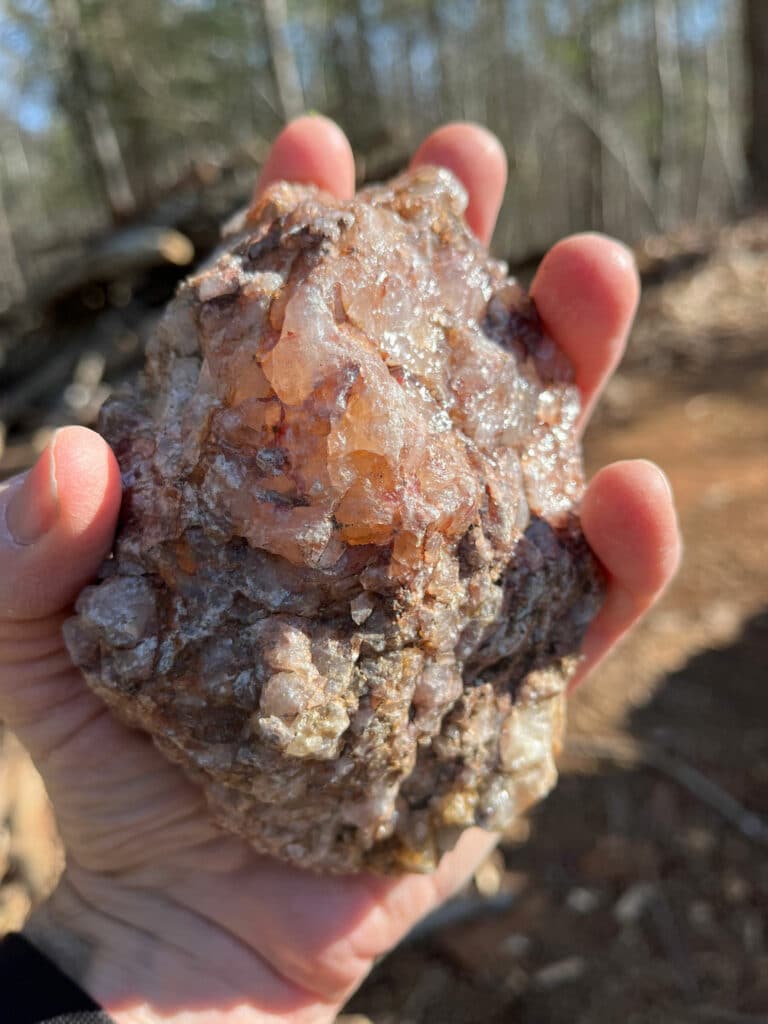Southeastern Tennessee existed in my mind as just a series of miserably winding mountain roads—until I happened to drive on the Cherohala Skyway on my way to the Tellico River. The road connects Robbinsville, N.C. to Tellico Plains, Tenn., and was named after the Cherokee and Nantahala National Forests it crosses: “Chero. . . hala.” The road opened in 1996 and was soon after designated a National Scenic Byway. The mountains here are a bit taller and more remote, the lakes are noticeably clearer and greener, and the rivers a tad steeper and more dramatic than in the rest of Appalachia. The drive treats you to one amazing view after another as you ascend peaks up to 5390 feet.
The views along this road are nothing less than awe-inspiring, but even more intriguing are the subtle hints of the Cherokee in these parts. Motorists aren’t bombarded by billboards advertising commercial reenactments or tourist traps thinly disguised as reservations. Like the scenery, the presence of the Cherokee can be found all around. The street signs are written in both English and Cherokee. In fact, the namesakes for the very land, rivers, and mountains in this area are derived from Cherokee words. When I heard that parts of the now Cherohala Skyway were once used by the ancient Cherokee as footpaths, I was less interested in rushing to the rivers to kayak and more curious to explore and find out more about the native people who once called these mountains home.
Cherokee Heritage
The Cherokee Nation occupied these mountains, surviving in this harsh country by growing crops, hunting, fishing, and gathering wild foods. The largest Native American group in the U.S., the Cherokee tribes spent centuries in Southern Appalachia. The Cherokees left their mark. In fact, Tennessee was actually named after the first capital of the Cherokee nation “Tanasi,” which means “big bend” and was used to describe what we now call the Tennessee River. In this area, so many of the rivers, forests, and mountains received their name from the Cherokee language.
The idea of seeking out a “wilderness experience” or spending time in nature would have been absurd to the ancient Cherokee. The Cherokees did not – and in fact could not – relegate the outdoors to a small place or time in their lives, so intertwined was their existence with nature. The Cherokee believed that the eagles, deer, snakes, fire, creeks, and mountains all had an intelligent spirit, which played a role in Cherokee myths and daily practices.

• • •
Five Must-Stops
Along the CherohAla Skyway
For a weekend, I channeled the spirit of the Cherokee and paused to wonder, if the trees could talk, what would they say? If the creeks could whisper, what secrets would they share? In order to find out, I marveled at the tall trees, gaped at the mountain views, hiked the balds, slept under the star-studded sky, and relished in the mist from cascading waterfalls.
Marvel at the Big Tree at Joyce Kilmer Memorial Forest
My first stop wasn’t even technically on the skyway. Driving from Robbinsville, the road literally ends at the top of Santeetlah Gap, leaving the driver with the choice to turn left onto the Skyway or right to Joyce Kilmer Memorial Forest. I turned right. The park offers a rare chance to walk through a virgin hardwood old-growth forest. The ancient Cherokees probably thought nothing of magnificent trees towering above, because they lived in a time before the logger’s saw devastated entire forests. Today, few old-growth tree stands remain throughout Appalachia.
I meandered along the Joyce Kilmer National Recreation Trail, a two-mile easy hike taking me into the heart of the forest. I stopped often to crane my neck upwards, taking in the gentle giants, some of which are over 100 feet in height and 20 feet in circumference. When I learned that some of the trees here have been around for nearly 400 years, I couldn’t help but touch them, thinking that a Cherokee Indian might have touched some of these very same trees hundreds of years ago.
That poplars remain is due to the remote mountainous location, making the effort to log cost prohibitive once the construction of a dam flooded the logging company’s railroad access. Along with the poplars, some 100 species of trees can be seen at Joyce Kilmer, including hemlock, red and white oak, basswood, beech, and sycamore. The forest is aptly named after the poet Joyce Kilmer, who wrote the poem, “Trees.”
Gaze at the Mountains from Santeetlah’s Overlook
For a peak experience, my next stop was Santeetlah’s Overlook that, at 5390 feet, is over a mile high. On a skyway full of beautiful views, Santeetlah’s Overlook is a must-stop. A stone’s throw from the paved parking lot, I looked out at the cloud-covered Great Smoky Mountains and the upper Santeetlah watershed. From where I stood, there was little evidence of civilization. I could not see a building, a bridge, or a road. The mountains faded into hills, seemingly stretching into infinity. A low-hanging fog danced around the mountains and trees, creating spirit-images that swayed with the breeze. Cloaked in fog, the mountains acquired a sense of mystery.
This vantage point provided me the same view a Cherokee would have had before the white men came to these parts. Since then forests have been destroyed to build towns and the landscape has been forever altered in many areas. Here, the mountains and hills remain unscathed. Where the tall trees tower above, the rivers flow freely, and mountain vistas are uninterrupted, it becomes plausible to imagine just how rugged and wild a world the ancient Cherokee inhabited.
The very ruggedness and remoteness of this area protected Cherokees during the time of the Trail of Tears. Some Cherokees who lived in the Cheoah Valley hid in these mountains and were saved the fate of being exiled to distant reservations. Their descendants live in a small Cherokee community near the town of Robbinsville, known as Tu Ti Yi, or Snowbird.
Hike to Hooper Bald
My next stop was Hooper Bald to hike the half-mile trail to the top. As I hiked, I wondered how the balds came to be at tops of mountains. Why, at heights where I expected to find large trees that otherwise grow in the Appalachia mountain chain, were there grassy meadows covered with shrubs and grass like tundra instead?
Turns out theories abound as to how the balds came to be, but my personal favorite theory is that Native Americans cleared the balds for sacred ceremonies. As I stood on those grassy expanses, it seemed entirely plausible that the Cherokees felt a spiritual connection on this spot, where nothing remained between the earth underfoot and the heavens above.
The Snowbird Backcountry Area can be accessed from this stop. The network of 37 miles of hiking trails leads to waterfalls and ridgetops, as well as access to the headwaters of Big Snowbird Creek.
Camp at Indian Boundary Lake
Tired after a day of hiking and demanding mountain driving, I couldn’t wait to pitch my tent at Indian Boundary Lake. I descended a two- mile road full of switchbacks to reach the lake, which covers 96 acres and sits at an elevation of 1,560 feet. The detour was well worth the effort – the pristine lake rimmed with pine trees and surrounded by mountain views was nothing less than stunning. The lake offers a swimming beach, a picnic area with grills, and a 3.2 mile hiking and biking trail around the lake.
But what my aching body cared most about was the campground. With 80-some campsites at Indian Boundary Lake, I had my choice of campsites that all offered the usual amenities such as a fire pit and picnic tables. What really set some campsites apart were the many docks and man-made peninsulas along the lake. The view I had from my perch on a floating dock couldn’t have been better if I were floating on my own personal boat in the middle of the lake. It was one of those clear nights when the Milky Way was visible. The surface of the lake reflected the stars above, and after gazing long enough I couldn’t discern where the sky stopped and the water began.
Relish in the Cool Mist from Bald River Falls
Refreshed after a good sleep, I headed off for Bald River Falls. After hearing that the falls are one of the most impressive and scenic waterfalls in Eastern Tennessee, I was eager to drive the five miles along the Tellico River to see for myself. Bald River is a powerful, dramatic short river. Just before Bald River joins the Tellico, Bald River cascades one hundred feet onto the boulders below. A bridge over this confluence allows a stunning platform from which to see the falls.
While the view from my car was pretty darn good, getting out and walking down to the base of the falls was even more impressive. From my view at the bottom of the falls, it was easy to see how the Cherokees believed that flowing water could help a person begin anew. The ancient Cherokee performed a ritual called “going to water” to cleanse the spirit and body. At a new moon, before special dances, after bad dreams, or during illnesses, Cherokee would step into a river or creek at sunrise, facing east toward the rising sun. They would dip under the water 7 times. When they emerged, they were said to be rid of bad feelings and have a clear mind. This ritual doesn’t seem much different from my own need to go kayaking when I have a difficult decision to make or need a fresh perspective on life.
I spent the better part of the day hiking the trail just above the falls, which follows Bald River for nearly 6 miles through deciduous forests. In summer, you can swim at the base of Bald River Falls or in pools on the Tellico River, and the lower Tellico River can’t be beat for tubing.
Parting Tips
The Cherohala Skyway is about as remote and wild as it gets in the Southeast. Bring plenty of food and water, pack your camera, and fill up your gas tank. There is very little cell phone service. Restrooms are few and far between, and there are no stores or gas stations along the skyway. Take your time. While it’s possible to drive the entire skyway in a couple of hours, to truly appreciate the diverse terrain you might want to consider taking a full day or longer. This is a place to linger and appreciate. For your efforts, you will be rewarded with breathtaking views and offered a glimpse into the lives of the ancient Cherokee people.
How the Cherohala Became a Skyway
Back in the 1950s, the people who called the rural communities in Southeastern Tennessee home felt isolated and desired to be connected to nearby mountain towns. In an effort to gain publicity for the need for a road linking Tennessee and North Carolina, at a Kiwanis meeting in April 1958, a local resident jokingly suggested club members organize a wagon train “since our roads are only fit for covered wagons.” Six weeks later, residents organized a wagon train consisting of 67 covered wagons and 325 horseback riders. They left Tellico Plains, N.C., on a 42-mile journey to Western North Carolina. Thus began an annual wagon train trek through the mountains. By 1967, the 10th anniversary of the wagon train, the construction of an actual highway began. The wagon wheel tracks of the annual trek created the skyway’s original path. After decades of construction and a price tag of $100 million, the Cherohala Skyway officially opened in October 1996. The US Forest Service estimated that five million cars a year would use the new road, which turned out to be an extremely unrealistic prediction. In reality, only twenty cars and 100 motorcycles a day use the skyway, most of which use occurs during the warmer months. The skyway is desolate in the winter.








